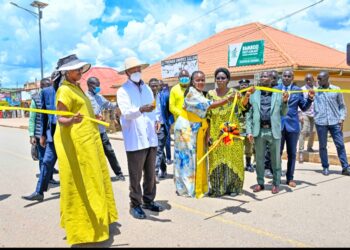The health sector of Uganda still faces numerous challenges in the delivery of health services, especially in rural areas. Although there exists Village Health Team (VHT) model, its service delivery has always lacked since they work in a voluntary capacity.
Despite their voluntary capacity, they act as the link between the formal health sector and their communities. As such, their motivation and thereby performance generally remains low yet they play a great role like data collection and reporting.
Also the lower-level health facilities face a challenge in the delivery of Essential Medicine and Health Supplies (EMHS), paper-based stock and inventory management systems that result in stock-outs and drug expiries.
As a way of addressing the above bottlenecks in the health sector, especially in low income communities, the United Nations Capital Development Fund (UNCDF) leveraging the power of digital technologies has offered opportunities through digital health solutions in some districts.
In conjunction with different partners such as BRAC and Medic, UNCDF under their theme of ‘leaving no one behind in the digital era’, has used different digital technologies to strengthen health service delivery, and improve health outcomes in lower communities.
Emerging technologies like drones, artificial intelligence, geospatial and big data provide opportunities such as innovative transportation, mapping of service, digital registry and data analytics have been put in place to innovatively bridge health information and delivery gaps and support decision making.
On strengthening the skills of the community health workers by leveraging the power of digital service delivery and training tools, UNCDF partnered with BRAC and Medic. Through this partnership, VHTs have been given a digital Community Health Toolkit (CHT) as a way of resolving the challenges of follow-up and supervision and performance of VHT.
According to Brian Ssennoga from Medic, the tool kit is a collection of open-source technologies and open-access resources developed by a community focused on global equity. Medic maintains it, its core framework is highly configurable and makes it easier to build scalable digital health apps.
At the community level, community health workers/VHTs use the apps built with the CHT to register patients, conduct guided health assessments, screen for specific conditions and danger signs and refer patients to health facilities.
According to UNCDF, digitally empowered CHWs can respond to the needs of their communities with more accuracy and efficiency through efficient task management and scheduling. Also, Digital empowerment for CHWs increases the district’s ability to access, receive and use healthcare data for decision support more routinely and more accurately which increases the local communities’ resilience to address healthcare challenges at the lowest level of the healthcare services delivery chain.
Partners like BRAC have also helped to improve the livelihood of VHTs through different poverty alleviation programs that have empowered many poor VHTs and this has been seen in districts like Koboko, Maracha, Lira and Nebbi where VHTs’ lives have positively changed.
Speaking to this website last week, Chris Lukolyo,UNCDF Digital Lead Uganda said investing in digitalizing Healthcare is UNCDF’s approach to leveraging technology and addressing some of the most challenging constraints in healthcare for rural communities in Uganda.
“Health is one of the key sectors the UNCDF focuses on as part of our digital strategy. ‘leaving no one behind in the digital era; which aims at enabling people in developing countries to use innovative digital services in their daily lives to improve their wellbeing,” he said.
To address the challenge of stock management in lower-tier health facilities, UNCDF partnered with Medical Acess Uganda Limited (MAUL) and Signalytic and developed a digital supply chain management solution to address the connectivity challenges of the last mile.
According to a recent report since the introduction of the above digital solution, there has been increased access to essential medicines through an effective digital supply chain management system at the primary healthcare level. The solution is seen as an effective solution for minimizing waste, reducing mortality rates, increasing responsiveness and drug availability and promoting rational drug usage.
Also, UNCDF in partnership with MAUL and Signalytic developed the platform an innovative digital solution that combines renewable solar power, powerful signal connectivity, durable hardware and custom off-grid blockchain technology to connect remote health facilities and health providers to a common decentralized network, even in facilities with no electricity or mobile network coverage.
This is purposely to ease drug distribution and efficient sharing of information between the facility store managers and the district health officers.
Do you have a story in your community or an opinion to share with us: Email us at editorial@watchdoguganda.com













